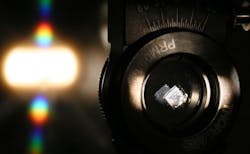Diamond optical gratings to enable new uses in spectroscopy and high-power laser control
Thanks to a new technique developed at École polytechnique fédérale de Lausanne (EPFL; Lausanne, Switzerland), optical diffraction gratings can now be made out of pure diamond, with their surfaces smoothed down to the atomic level. These new devices can be used to spectrally control high-powered lasers or in cutting-edge spectrographs. The technique was presented at the International Conference on Diamond and Carbon Materials DCM2017 (5 September, 2017; Gothenburg, Sweden).
Diamond gratings have properties that are ideal for both spectroscopy and the optical components used in high-powered lasers. Diamonds are unmatched in terms of their thermal conductivity, which is between five and ten times greater than that of any other material used for this purpose. Diamonds are also chemically inert, extremely hard, and work well with UV radiation, as well as infrared and visible light.
Oxygen cuts diamonds
The technique developed by the team, which was led by EPFL professor Niels Quack, is groundbreaking because it allows well-defined shapes to be etched into millimeter sized single-crystal diamond plates, with the grooves separated by just a few microns and with atomically smooth surfaces. The researchers used synthetic diamonds created via chemical vapor deposition (CVD).
The diamonds are etched in several stages. First, a hard mask is deposited and structured on the surface of a diamond plate, which is then exposed to an oxygen plasma. The oxygen ions in the plasma are accelerated onto the surface of the diamond by an electric field. Where not covered by the hard mask, the oxygen ions remove carbon atoms from the diamond's surface one by one.
"By adjusting the intensity of the electric field, we can alter the shape we etch into the diamond," says Quack. "For the diffraction gratings, we carve out triangular grooves that are just a few microns apart from each other. We adjust the process parameters to selectively reveal a set of well-defined crystal planes, allowing us to create V-shaped grooves that are smoothed down almost to the atomic level. It is impossible to get this kind of precision when the diamonds are simply cut with a laser."
This new technology, which was developed using the facilities in the Center of MicroNanoTechnology (CMI), is the subject of a recent patent application. The same principle has already been used using silicon, but it had never before been demonstrated in diamond. In recognition of the importance of this contribution, doctoral student Marcell Kiss has been shortlisted as one of the six finalists of the Young Scholar Award DCM2017.
Source: https://actu.epfl.ch/news/carving-diamonds-for-optical-components/

John Wallace | Senior Technical Editor (1998-2022)
John Wallace was with Laser Focus World for nearly 25 years, retiring in late June 2022. He obtained a bachelor's degree in mechanical engineering and physics at Rutgers University and a master's in optical engineering at the University of Rochester. Before becoming an editor, John worked as an engineer at RCA, Exxon, Eastman Kodak, and GCA Corporation.
